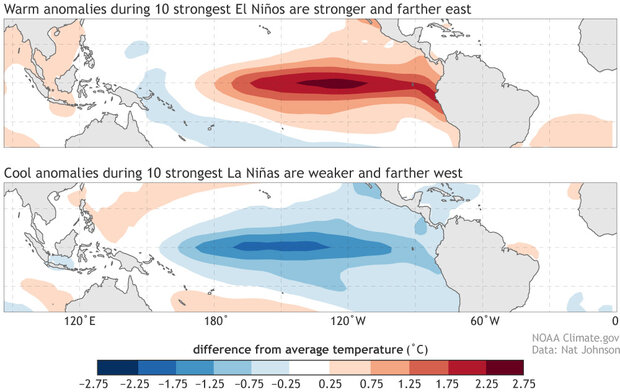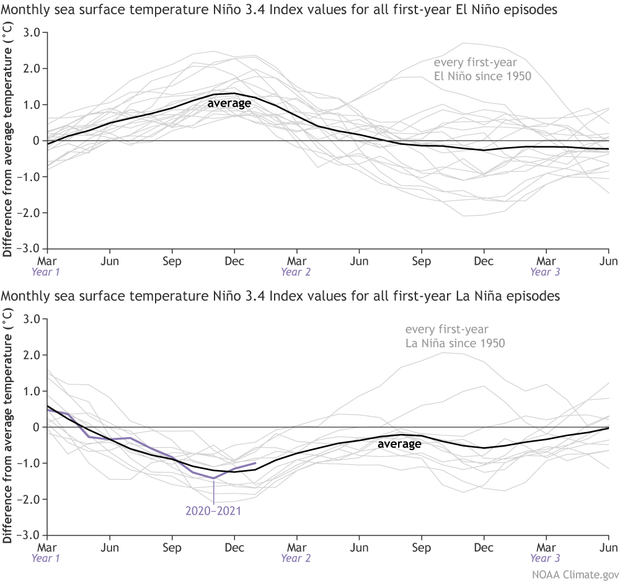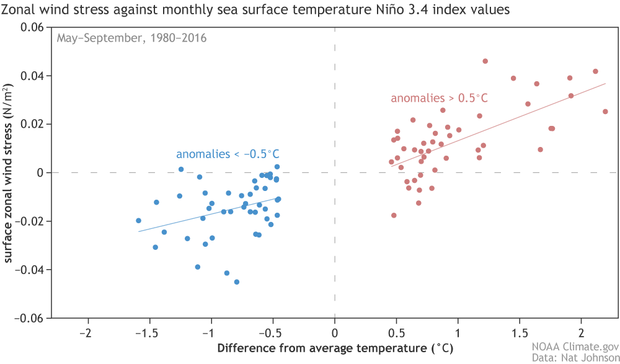Double-dipping: Why does La Niña often occur in consecutive winters?
As the 2020–21 La Niña has come to an end, leaving us with neutral conditions in the tropical Pacific, we now wonder if we have seen the last of La Niña for a while or if we will see another dip into La Niña conditions by next fall. In the world of the El Niño-Southern Oscillation (ENSO), double-dipping is not a party foul—it’s actually quite common for La Niña to occur in consecutive winters (not El Niño, though). If you’re wondering why, then this is the blog post for you!
Mirror, mirror on the wall
To understand why La Niña commonly double dips, we first need some basic understanding of ENSO asymmetry. Often, we think of El Niño and La Niña as mirror opposites—for example, that the warmer-than-average east-central tropical Pacific conditions during El Niño are exactly matched by the cooler-than-average conditions of La Niña. This mirror-opposites perspective is a pretty good approximation, but it’s not perfect!
Average November – January sea surface temperature anomalies (°C) for the top 10 strongest (top) El Niño and (bottom) La Niña events since 1950 based on the November – January Niño3.4 index. Anomalies are calculated with respect to 30-year base periods updated every 5 years (see here for a description). NOAA Climate.gov figure with ERSSTv5 data obtained from the NOAA Physical Sciences Laboratory.
Upon closer inspection, we see some subtle but important differences between El Niño and La Niña in terms of their patterns and behavior. First, the sea surface temperature anomalies (difference from the long-term average) during El Niño tend to be centered farther east than for La Niña, especially for the stronger El Niño episodes. Second, the strongest El Niños tend to be stronger than the strongest La Niñas. We can see these differences in the maps above. The warm anomalies in the eastern Pacific for the El Niño composite are between 2.25 and 2.75 degrees Celsius (4 and 5 degrees Fahrenheit), while the cool anomalies in the east-central Pacific for the La Niña composite top out at 2.25 degrees C.
Monthly sea surface temperature anomalies in the Niño 3.4 region of the tropical Pacific for (top) all first-year El Niño and (bottom) first-year La Niña winters since 1950, starting in the March before the first-year peak. Climate.gov graph based on ERSSTv5 temperature data.
We also see notable differences in how sea surface temperatures in the Niño 3.4 region of the Pacific change over time for first-year El Niños (meaning, the previous winter did not feature El Niño) and first-year La Niñas. After the peak of El Niño, which typically occurs in late fall or winter, Niño3.4 surface temperatures usually decline rapidly to neutral conditions by the following spring. In the ensuing summer through winter, ENSO neutral conditions continue, or La Nina develops, but the occurrence of El Niño in a second consecutive winter is uncommon.
For La Niña, in contrast, the return to ENSO neutral after the late fall peak is usually more gradual, and, as Emily recently reminded us, the transition to El Niño after the first winter of La Niña rarely occurs. Instead, we generally see ENSO-neutral or a transition back into La Niña conditions by the following fall, as shown by that second dip in average Niño3.4 temperatures in the plot above. To reiterate what Emily already noted, of the 12 first-year La Niña events on record, 8 were followed by La Niña the next winter, 2 by neutral, and 2 by El Niño.
All things being unequal
Things would be simpler if El Niño and La Niña behaved similarly, so why are the transitions out of El Niño and La Niña so different? The answers lie in the processes that cause El Niño and La Niña to strengthen and weaken. Several months ago, Michelle introduced us to the essential processes for ENSO, the fun-to-say Bjerknes feedbacks. Essentially, Bjerknes feedbacks describe the reinforcing interactions (positive feedbacks) between the ocean and atmosphere that cause El Niño and La Niña to grow: changes in the tropical Pacific ocean temperatures cause changes in the overlying trade winds, which then cause additional, reinforcing changes in the ocean temperature (please see Michelle’s post for more of the details!).
May–September monthly zonal (east-west direction) wind stress anomalies against the monthly sea surface temperature anomalies in the Niño 3.4 region from 1980-2016. The wind stress anomalies corresponding to La Niña conditions (blue dots) are averaged over the central tropical Pacific from 5°S - 5°N and 167°E - 153°W. The wind stress anomalies corresponding to El Niño conditions (red dots) are averaged farther east, 5°S - 5°N and 179° - 139°W. These regions have the strongest relationship with the Niño 3.4 index and are chosen following Choi et al. (2013). The steeper slope of the linear fit to the red dots relative to the linear fit to the blue dots indicates a stronger zonal wind stress response under El Niño conditions. NOAA Climate.gov figure based on MERRA Reanalysis wind stress data and ERRSSTv5 sea surface temperature data.
If all essential processes that comprise this feedback process were equal but opposite for El Niño and La Niña, then we might expect mirror opposite patterns. However, this isn’t the case. For example, the response of the trade winds to the Niño3.4 surface temperatures is unequal between warmer and cooler surface conditions. We see this above in the scatter plot of monthly May–September zonal (east-west direction) wind stress anomalies (1) in the equatorial Pacific versus the Niño3.4 surface temperature anomalies. As we expect, warmer Niño3.4 surface temperatures that are tied to El Niño conditions bring weaker trade winds and a weaker Walker circulation (positive wind stress anomalies), whereas cooler Niño3.4 conditions bring stronger trade winds (negative wind stress anomalies) connected with a stronger Walker circulation.
However, the plot also reveals that the relationship between the warm (El Niño) and cool (La Niña) sea surface temperature anomalies and the wind anomalies they generate is not equal. El Niño’s warm water anomalies generally produce wind stress anomalies that are stronger and farther east than those produced by cool La Niña anomalies of equal strength. The stronger response is demonstrated by the steeper slope of the red line versus the blue line. This difference may seem a bit subtle, but it can have big consequences for ENSO asymmetry (2).
The strength of the coupling between the winds and upper ocean matters because it not only strengthens El Niño and La Niña, but it also sets the wheels in motion for the ultimate demise of each event. The strong coupling between ocean and atmosphere and the more eastward wind stress anomalies during El Niño contributes to a robust poleward discharge of equatorial Pacific upper-ocean heat, typically by early spring, that ends the El Niño event and sets the stage for the next La Niña. The weaker coupling and more westward wind stress anomalies during La Niña means that the corresponding “recharge” of heat is also weaker, and so the ocean is not as primed for a transition to El Niño. Instead, if we experience the right sequence of tropical weather, a second winter of La Niña may return instead (3).
The scenario I have described is far from complete, as there are many other atmospheric and oceanic (and even biological!) processes that likely contribute to ENSO asymmetry and the tendency for La Niña to persist for more than one winter (4). There is still considerable debate about which processes are most important for these El Niño/La Niña differences (still so much unsettled ENSO science!).
A heads up?
Can we predict when La Niña will double-dip? Some recent studies suggest that we may be able to predict (in a probabilistic sense) more than a year in advance the likelihood of two-year La Niña based on the strength of the preceding El Niño and poleward discharge of equatorial heat (5). However, the most recent La Niña is a bit unusual because El Niño did not immediately precede it, and so it is difficult to identify any clear indicators that La Niña will return next fall at this time. Although we must await further guidance to get a better handle on the forecast, we at least can say that both history and the current ENSO forecast suggest that El Niño is unlikely to return in the near future.
Special thanks to Dr. Andrew Wittenberg for guidance and helpful comments while preparing this blog post!
Footnotes
(1) Wind stress measures the lateral force per unit area that the wind exerts on the ocean surface. A “positive zonal wind stress anomaly” corresponds to an anomalous eastward force on the ocean surface, exerted by a stronger-than-average eastward component of the winds; this weakens the normally westward force exerted by the trade winds. Conversely, negative zonal wind stress anomalies indicate a stronger westward force on the surface ocean, exerted by stronger-than-average westward trade winds.
(2) The zonal wind stress analysis of this post is modeled after Choi et al. (2013). That study provides conceptual and theoretical support for the hypothesis that the asymmetry in zonal wind stress response to tropical Pacific sea surface temperatures, like what is shown in the scatter plot of this post, is sufficient for explaining many of the asymmetries between El Niño and La Niña, including the tendency for La Niña to persist for more than one winter (see the next footnote for additional details).
Choi, K.-Y., G. A. Vecchi, and A. T. Wittenberg, 2013: ENSO transition, duration, and amplitude asymmetries: Role of the nonlinear wind stress coupling in a conceptual model. Journal of Climate, 36, 9462-9476. https://doi.org/10.1175/JCLI-D-13-00045.1
(3) For those of you who are interested in more of the scientific details about how this wind stress asymmetry between El Niño and La Niña may contribute to the tendency for La Niña to double-dip, this footnote provides additional, more technical discussion, courtesy of Dr. Andrew Wittenberg.
ENSO events are sparked by a disequilibrium between two coupled ocean/atmosphere time scales in the response to wind changes: a fast equatorial adjustment (oceanic equatorial Kelvin waves + Bjerknes feedbacks), and a slow off-equatorial adjustment (curl-induced oceanic Rossby waves and delayed negative feedbacks).
Equatorial wind anomalies that are located farther east (as during a strong El Niño) induce more transient growth, disequilibrium, and overshoot into the opposite phase, for 2 key reasons. (1) Their resulting zonal current anomalies & upwelling anomalies are located closer to the warm pool edge in the central Pacific and shallow thermocline of the east Pacific. This strengthens the transient growth via fast equatorial processes (zonal advective feedback and Ekman feedback, two of the important Bjerknes feedbacks), which amps the wind anomalies so much that they can over-discharge the equatorial thermocline several months later. (2) When the off-equatorial wind stress curl anomalies are located farther east, they’re also farther from the western boundary, and so their resulting off-equatorial oceanic Rossby wave trains have farther/longer to travel before they can reflect back onto the equator and start the turnabout of the ENSO event. This enables the equatorial disequilibrium to grow more strongly before being impeded & eventually reversed by the delayed negative feedback. Thus, the more eastward-shifted zonal wind stress anomalies during strong El Niños enable stronger transient growth & disequilibrium, increasing the over-discharging and subsequent overshoot.
In short, under the “zonal wind stress asymmetry hypothesis” of Choi et al. (2013), La Niña is more likely to double-dip because its winds stress anomaly is so far from the “sea surface temperature-ticklish” zone of the central/eastern Pacific, and so close to the western boundary “transfer station” for the off-equatorial feedbacks, that La Niña just can’t get as much of a disequilibrium going – and hence can’t over-charge the equator enough to guarantee an overshoot into El Niño.
(4) For a comprehensive review of existing hypotheses for ENSO asymmetry, I recommend An et al. (2020).
An, S.-I., E. Tziperman, Y. Okumura, and T. Li, 2020: ENSO irregularity and asymmetry. In A. Santoso, M. McPhaden & W. Cai (Eds.), El Niño Southern Oscillation in a changing climate (pp. 153– 172). John Wiley & Sons.
(5) For example, a few recent studies, including two led by Dr. Pedro DiNezio, suggest that the probability of a multi-year La Niña may be skillfully predicted 18-24 months in advance, given a preceding El Niño. The sources of skill are rooted in the strength of the El Niño and the magnitude of poleward heat discharge 6 months after the peak of El Niño.
DiNezio, P. N., C. Deser, Y. M. Okumura, and A. Karspeck, 2017a: Predictability of 2-year La Niña events in a coupled general circulation model. Climate Dyn., 49, 4237–4261, https://doi.org/10.1007/S00382-017-3575-3.
DiNezio, P. N., C. Deser, A. Karspeck, S. Yeager, Y. Okumura, G. Danabasoglu, N. Rosenbloom, J. Caron, and G. A. Meehl, 2017b: A 2 year forecast for a 60–80% chance of La Niña in 2017–2018. Geophys. Res. Lett., 44, 11 624–11 635, https://doi.org/10.1002/2017GL074904.
Wu, X., Y. K. Okumura, C. Deser, and P. N. DiNezio, 2021: Two-year dynamical predictions of ENSO event duration during 1954–2015. J. Climate, 34, 4069-4087, https://doi.org/10.1175/JCLI-D-20-0619.1.



Comments
Compliment
Hey guys thank you for this amazing blog! I really appreciate and learn tons of new things! you're amazing!
La Nina Teleconnections 2020-2021
Here along the west coast, the La Nina'ish teleconnections (not necessarily SSTA's at that point) suggests an atmospheric origin in 2019-20 prior to the oceanic La Nina 2020-21. Since the same anomalous Wx pattern is persisting through 2020-21 (resulting in 2 yrs of record heat and drought),
is it possible that 2021 was really the 2nd year of La Nina (weather-wise) and we may now hope for a slow return to more normal conditions in 2021-22?
RE: La Nina Teleconnections 2020-2021
Hi Craig, La Nina isn't the only game in town when it comes to influencing West Coast weather. Sometimes other climate phenomena or just the randomness of our atmosphere can lead to similar weather patterns to La Nina but have nothing to do with the tropical Pacific. In 2019-2020, there was no active La Nina in the Pacific, but that doesn't mean that drought couldn't happen in the West Coast. It's just bad luck that there was a dry year preceding the La Nina which often also leads to drier outcomes for parts of the West Coast.
Doubel-dipping
Thank you very much for such interesting blog
Double Dipping: Why Does La Niña ...
Thank you, Nat Johnson, and all others that contributed to the best explanation I've ever read on this weather phenomenon. As I'm only an "armchair" meteorologist at best, I appreciated the links to explain some terms I wasn't familiar with, as well as the impressively clear charts. Well done!
La Niña study
As a cattle and game farmer in South Africa, I find this study/analysis very useful as it allows us to prepare to grow our stocks to feed our populations in a sustainable way. Thanks so much. 👍
Thanks so much! It's great…
Thanks so much! It's great to hear how this is information is used in different ways around the world.
3rd consecutive year?
Hi, what are the chances of El Niño and the rain returning again for 22-23?
Three-peat la Nina pattern
As I look at through the decades of past episodes of seemingly 4, and not just 3, long-term la Nina episodes of more than 2 years, (especially to include the winter months), I see that they rather robustly occur every 22 years. The correlation is found in every other (odd numbered) solar cycle as upticks flip every 11 year cycle from a northern polarity to a southern polarity and then back again. Meanwhile, every new solar cycle upstart seem to favor a la Nina, which have been declining in episode strength lately. The mid cycle peak of sun spot activity with a lag of hot solar wind favor warmer conditions as they should. The sun is 99.8 of the mass of our solar system and maybe doing more driving than we have known, or at least illuded too.
Just like hurricane season lags into the late fall past peak heating, there is likewise a bit of a lag-effect following an uptick in new sun spot activity. The magnetic fields flipping back to "normal" every other 22 year clearly have this triple-dip tendency. (give or take a couple of "neutral" months seen during 1974 and 2021 triple-dip runs), maybe there is a 44 year bump in this road too, or just the fact that we are headed into another grand solar minimum. Either way, the declining sun spot activity over the last 40 years may also be influencing the weaker tendency of the strength of both warm and cold climate cycles. That's my two Indian cents. #happynativeamericanheritagemonth
Keep your eyes on our…
Keep your eyes on our monthly updates posted here (2nd Thursday of each month):
https://www.cpc.ncep.noaa.gov/products/analysis_monitoring/enso_advisory/ensodisc.shtml
Our official probabilities (which are linked at the end of the second paragraph) are here:
https://iri.columbia.edu/our-expertise/climate/forecasts/enso/current/?enso_tab=enso-cpc_plume
Right now (and this will update monthly) we are around 35% for the summer and fall.
Add new comment